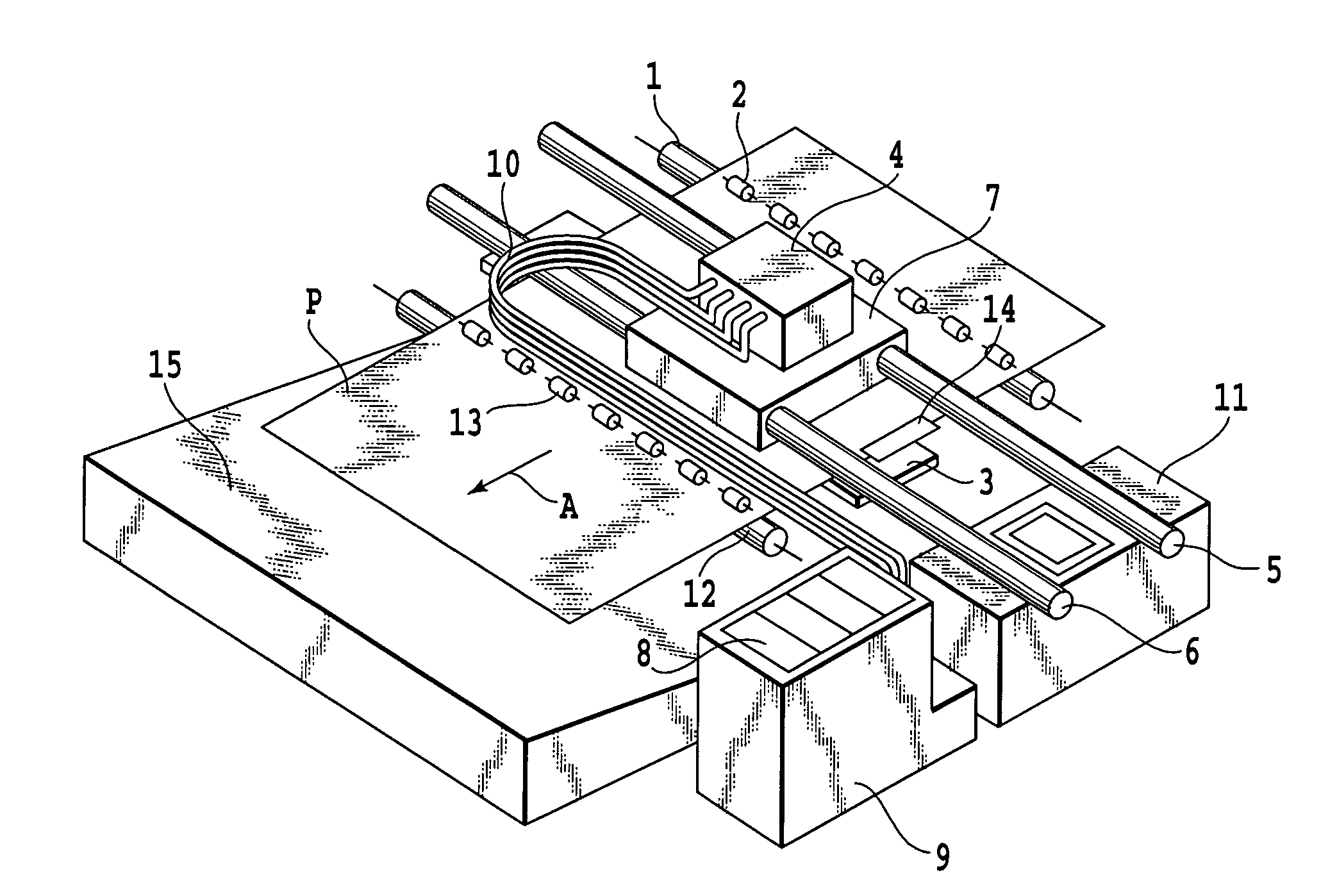Inkjet printing apparatus and inkjet printing method
a printing apparatus and inkjet technology, applied in the direction of printing, other printing apparatus, etc., can solve the problems of image defects, printing mediums that are likely to be placed in unstable conditions, and the accuracy of printing mediums is likely to be reduced, so as to reduce density unevenness and reduce distance
- Summary
- Abstract
- Description
- Claims
- Application Information
AI Technical Summary
Benefits of technology
Problems solved by technology
Method used
Image
Examples
first embodiment
[0059]FIG. 1 is a perspective view showing an overall configuration of an inkjet printing apparatus according to one of the embodiment of the present invention. While a printing is performed, a printing medium P is held between a conveying roller 1 arranged on a conveying path and pinch rollers 2 driven by the conveying roller 1, and is conveyed in a direction indicated by an arrow A in FIG. 1 while guided onto and supported by a platen 3 in response to the rotation of the conveying roller 1. The pinch rollers 2 are elastically biased toward the conveying roller 1 by a pressing member such as a spring, which is not illustrated in FIG. 1. The conveying roller 1 and the pinch rollers 2 are components constituting a first conveying unit located upstream in a direction in which the printing medium is conveyed.
[0060]The platen 3 is placed in a printing position which is opposed to a face (or an ejection face) of an inkjet-head typed printing head 4 where ejection openings are formed. The...
second embodiment
[0108]FIGS. 19A, 19B and 19C are diagrams each showing a configuration of nozzle arrays in a printing head adopted for a second embodiment of the present invention, and concurrently each used for explaining how the nozzles are used for the central portion, the transitional portions, as well as the front and rear end portions. The printing head according to the present embodiment includes nozzle array 41Gy for the grey (Gy) ink in addition to nozzle arrays 41C for the cyan ink, nozzle array 41M for the magenta ink, nozzle array 41Y for the yellow ink, and nozzle array 41Bk for the black ink. The number of nozzles in each nozzle array, a density with which the nozzles are arranged in the printing head, and the grouping of the nozzles in the printing head are the same as those in the first embodiment. A numeric value in each block representing each group indicates a print allowing rate of the group. Hatched nozzle groups (or groups whose print allowing rate is not equal to 0 (zero)) be...
third embodiment
[0113]Each of the foregoing embodiments shifts the position of the nozzle-use range in the nozzle array for the specific (or black) ink from the positions of the nozzle-use ranges in the nozzle arrays for the other color inks (or the chromatic color inks), and makes the size of the nozzle-use range for the black ink different from the size of the nozzle-use ranges for the chromatic color inks, when these nozzle-use ranges are used for each of the transitional portions. However, the present invention shall not be limited to the foregoing embodiments if there is another embodiment which is capable making the position of the peak of the brightness variation different among each colors in transitional portion by expanding the width of the overall brightness variation, and accordingly of reducing the absolute value of a value obtained by combining the peak values of the brightness variations concerning the respective colors as well.
[0114]FIGS. 22A, 22B and 22C are diagrams each showing a...
PUM
 Login to View More
Login to View More Abstract
Description
Claims
Application Information
 Login to View More
Login to View More - R&D
- Intellectual Property
- Life Sciences
- Materials
- Tech Scout
- Unparalleled Data Quality
- Higher Quality Content
- 60% Fewer Hallucinations
Browse by: Latest US Patents, China's latest patents, Technical Efficacy Thesaurus, Application Domain, Technology Topic, Popular Technical Reports.
© 2025 PatSnap. All rights reserved.Legal|Privacy policy|Modern Slavery Act Transparency Statement|Sitemap|About US| Contact US: help@patsnap.com



